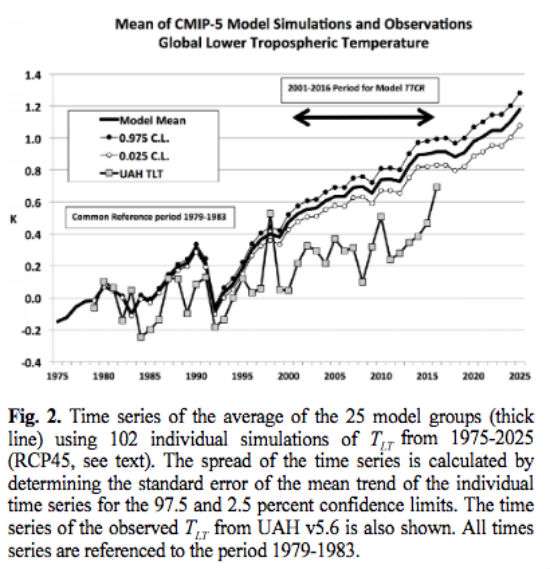Global Temperature Increases Are Lower and Slower, Says New Study
"We calculated that value as 1.1 C (almost 2° Fahrenheit), while climate models estimate that value as 2.3 C (about 4.1° F)"

A new study using more than 38 years satellite and weather balloon temperature data hypothesizes that global temperatures are going up more slowly than projected by most climate models.
And right on time, these results were challenged by other researchers who defend the scientific climate consensus as embodied in Intergovernmental Panel on Climate Change reports.
The new study done by University of Alabama in Huntsville climatologists John Christy and Richard McNider published in the Asia-Pacific Journal of Atmospheric Science argues consensus models may not have accurately captured how storms in the tropics expel excess heat back into space and/or that they have failed to account for how heat is absorbed by the world's oceans.
Christy and McNider took into account the effects of volcanic eruptions (cooling) and El Nino (heating) and La Nina (cooling) perturbations on global temperatures during the past 38 years.
What they found was warming in the lower troposphere where the bulk of our planet's atmosphere is located at a rate of about 0.096 degrees Celsius per decade. This trend implies that global temperatures will be about 1.1 (± 0.26) degrees Celsius warmer at the time carbon dioxide produced from burning fossil fuels and land use changes doubles in the atmosphere. This is about half of the Intergovernmental Panel on Climate Change's (IPCC) estimate of 2.31 (± 0.20) degrees Celsius warmer for a doubling of atmospheric carbon dioxide.

"From our observations we calculated that value as 1.1 C (almost 2° Fahrenheit), while climate models estimate that value as 2.3 C (about 4.1° F)," Christy said in a press release. "Again, this indicates the real atmosphere is less sensitive to CO2 than what has been forecast by climate models. This suggests the climate models need to be retooled to better reflect conditions in the actual climate, while policies based on previous climate model output and predictions might need to be reconsidered."
John Abraham, a professor of thermal and fluid sciences at the University of St. Thomas School of Engineering in Minnesota, asserted in The Daily Mail that Christy and McNider have "manipulated the raw measurements to decrease warming by about 38 percent."
If by manipulate, Abraham means that Christy and McNider have tried to take into account the effects of volcanic eruptions sending cooling sulfur dioxide into the stratosphere and the large swings in global average temperatures caused by the natural El Nino and La Nina phenomenon, then yes. They have done nothing underhanded or wrong.
It is hard not conclude that Abraham is being disingenous when he accuses Christy and McNider of data manipulation. Abraham must know the surface temperature datasets relied upon by IPCC are also "manipulated," using homogenization procedures to take into account weather station moves, instrument changes, time of observation changes, and urban heat island biases.
If the amount of warming expected from a doubling of carbon dioxide is much lower than most climate models project that implies that catastrophic climate outcomes are less likely and that humanity will have extra time to adjust to whatever warming eventually results from the increase in the carbon dioxide in the atmosphere.


Show Comments (111)